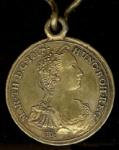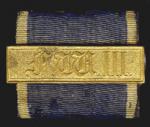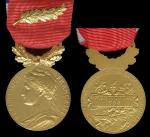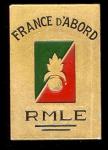-
Posts
782 -
Joined
-
Last visited
-
Days Won
2
Content Type
Profiles
Forums
Blogs
Gallery
Events
Store
Everything posted by Veteran
-
Hendrik is right. This is the current Croix de la Valeur militaire (CVM), created during the Algerian war in the 1950s and continued since. This cross is worn when a mention in dispaches (citation) has been won. Its ribbon should ALWAYS carry an device (star or palm according to the Military Command who awarded the MID). It can be bought from the French Mint without the devices, these being added according to the individual requirement. Cost is about 15Euro (?11). Men in the Foreign Legion, as members of any other unit liable to go into combat, have received this award when it was earned. CVMs are still being awarded in Afganistan and elsewhere. No one can tell if a CVM was awarded to a member of the Foreign Legion without its citation. Best regards Veteran
-
Hello PK I was very interested by the story about the fighting in Saint-Denis in 1944. Indeed, I had never heard it mentioned, nor had I read anything about it. You recall the gallant fighting the F.T.P. performed there, which I am sure is quite true. Allow me, nevertheless, to differ with some of your statements about the men who made up the F.T.P. troups. A significant number of them were no doubt former Spanish Republican soldiers who had escaped the Frankists by coming over the Pyrreneese border into France when their cause was lost. They were interned in very poor conditions by the French and later some of them managed to join "maquis" units formed by the F.T.P. who were, indeed, strongly influenced by the communist party. They were also joined by veterans of the International Brigades, many of them French, who had fought on their side in Spain. But the bulk of the F.T.P. were Frenchmen. The number of ex-Foreigh Legionnaires in their ranks is debatable. Please allow me to modify somewhat your description of the legionnaire :"French bad boys who pretended to be Belgians to get in". The Foreign Legion is often mistaken for other units called Bataillons d'infanterie l?g?re d'Afrique", "Bat'd'Af" in French military slang where French bad boys who were serving time in prison for civilian crimes were sent when they were of age for conscription. Such units have been disbanded for many years. The Foreign Legion was, and remains, an elite corps of professionnal soldiers from all countries in the world, serving under contract to France. It is true that Frenchmen were not allowed to enlist as such : the rest of the French forces were open to them. If a Frenchman wished, for any reason of his own, to join the Foreign Legion the tradition was to do so as a citizen or a subject of any other country of his choice. During both World Wars a special unit of the Foreign Legion was formed, the Regiment de Marche de la Legion Etrangere (R.M.L.E.). It is one the most heavily decorated regiment in the French Army. Among other distinctions, it is one of the very few non-American military units to have received a Presidential Unit Citation from the U.S.A. During WW2 it was part of the French 5th Armoured Division. It was engaged in France in November 1944 to crack German resistance int the Belfort area and fought its way to the Austrian border next May 1945; at the cost of 506 killed, 1311 wounded, out of an original complement of less than 1500 officers and men. Fighting the German Wehrmacht was a very dangereous job in thoses days, they were were experienced warriors and sincerely felt they were defending their fatherland. I happen to know, being one of the survivors. We all enjoy chatting on this excellent forum. I hope I have not been to "heavy". Very best regards Veteran
-

Austria-Hungary Austro-Hugarian Empire
Veteran replied to Veteran's topic in Austro-Hungarian Empire
Thank you very much. I really feel I understand this medal better. I will try to go further in depth if possible. Best regards to everyone Veteran -
Thank you ever so much for the wonderful tip you gave me, putting me on all this material which was published on this forum. I can quite see what you mean : they were a tradition with German States. Mine has seen a lot of service : the ribbon faded to a point, rather fraid on the edges and the pin in the back was broken off. But it certainly looks like the Prussian Army badge for 20+ years of service. Enjoy your collecting. I sincerely hope to be able to return some help to you one day. Sorry about the trees, the Fall in New-England is usually such a glorious sight. Cheers Veteran
-

Austria-Hungary Austro-Hugarian Empire
Veteran replied to Veteran's topic in Austro-Hungarian Empire
Thanks to all of you for this wonderful help. Haynau will find the reference to the medal in Prochazka under N?1092, page 125 "Verdienstmedaille f?r die ungarishen Truppen im Schlesischen Krieg". I will be grateful for his comments. Thank you Paul for your help and advice. You know how highly I value your wonderful knowledge of Orders and medals world-wide; yes, the pictures were enlarged for better reading, the medal being 27mm as described in the book refered to supra. I am very pleased you feel it looks right. Enzo, it is wonderful that you should refer to Prof. Fatovich who very kindly showed me a large part of his fantastic collection, just a few months before he departed this World. He was a very distinguisehd gentleman and an outright lover of Austrian Orders and Medals. I am delighted you feel it is a rare piece. Strangely, it was bought years ago in one of the shops of the Paris Flea Market, just because it appealed to me. It has been sleeping in a drawer for a very long. If it had not been for this excellent forum, I would probably never been able to appreciate it. I am very grateful, and will be pleased to learn as much about it as possible. Sincerely Veteran. -
Thank you Rick for this useful answer. I had no idea at all what it is. The back shows the bar strongly welded to a metal square and the ribbon sown with black thread. A non-nonsense arrangement, not an elaborate job as a military taylor outfitter would produce. A quick look into the Nimmergut brings me to mention the badge is 43mm across I will get you a scan as soon as possible. All my best to New England ! Are the leaves turning gold yet? Regards Veteran
-
Hello all members I am puzzled about this medal . It is gilt (silver?) 27mm diameter. According to v. Prochazka (?sterreichisches Ordenshanbuch, M?nchen 1974) it is the Service Medal for Hugarian troups in the Silesian War of 1748. It looks quite all right to me, but I wonder about a medal that old. How does one know it is an original? Restrikes may have been made, how can one tell them? The book I mentioned does not carry a picture of one. But there is one in v. Falkenstien, unfortunately very poor. Would an original be rare? Comments and advice will be gratefully received. Thank you. Very best regards Veteran
-
Chris This man was killed in action (tu? ? l'ennemi) in the CRAONNE area (secteur de Craonne) in departement (county) of Aisne, in Northern France. The note also tells he was killed in one of the trenches, the precise name of which I am unfamiliar with, and therefore cannot second guess. The last mention on this paper is a decision of a Court oF Justice establishing that he was officially killed in action. This might mean that his body was not recovered. Such papers were necessary for the widow in order to obtain a pension, or give his children the status of "Pupille de la Nation". Does that help ? Best regards Veteran
-
Hello Tim, It seems you have it all. Congratulations for this fine picture of the hallmarks. How do you produce them? All the best Veteran
-
Quite definitely. The official hallmark is the cornocupia with additionnal marking for the metal or metal content of the alloy. The first hallmarks for the French Mint (which is a Government Agency) were started in the 1830s and never have been discountinued since. They have changed a number of times during the XIXth century, but not since the 1870s. You might like to take a look at the series of messages following Darrel's message on the French Medal for Long Services (or "medal of labour") in the French section of this forum. One of the ways it is used appears on the reverse of a gold medal. Table medals also receive the Mint hallmark with the indication of the metal : BRONZE, ARGENT, OR. Privately struck table medals also have hallmarks, usually in a triangle, always ont the side of the medal. I hope this answers your question. Enjoy your collecting ! All the best Veteran
-
Hello Tim, I checked with the Paris Mint and they said this medal had not been in stock "for a very long time". No restricking is contemplated either. These large medals occasionnally appear on the french versrion of eBay in the "Medailles et jeton". The number of true collectors seems to be rather small and I find that they sell at very reasonnable prices, often less than their cost as new from the Mint. Il is just a matter of patience. Professionnal numismatists don't often have them, precicely because of the small number of collectors. I have a copy of the Catalogue I mentioned in a previous message. I will be happy to send information about french medals you may want to know more about. Enjoy a pleasant week-end. Paul
-
Hello Darrell Since you asked for further pictures showing the series of French Medals of Honor for Long Services (rather than Labour), I have put these pictures together for you and for the forum to see. As was previously reported, most "gold" medals are struck in gilt silver by the Paris Mint. This can be seen by the numeral 1 between two cornocupiae at 7H on the the reverse of the medal. The 1 means the finest alloy used by the Mint, which is 950/1.000 pure silver. They can also be obtained in 18 carat gold, which is the 3rd finest alloy used by the Mint. This is why the hallmark on the reverse is 3 between two cornocupiae at 7H on the reverse. Such gold medals are quite expesive, depending on the current value of fine gold. At this time, they probably cost upward of $1,000 new (750 Euro). A silver gilt medal for the same level would be about 85 Euro (approx. $110). But, rather strangely, gold medals can be occasionnally bought from dealers or on eBay for considerably less ($150-250). I hope this addition proves useful. Very best regards Veteran
-
Good morning Both the Verdun and Marne medals were struck by the Paris Mint (Administration des Monnaies et Medailles) and appear in vol. 3 of their "Catalogue general illustre des Editions de la Monnaie de Paris". This means they were (and possibly still are) available for sale. They were usually bought as a souvenir or as a gift to veterans who had fought in those battles. They were also available to collectors who enjoyed the beauty of medals or their symbolic significance. In some instances, only a given number of medals were struck, once and for all. Other medals are occasionnally restruck in order to keep the stock alive. Basically the Mint is a government agency, and as such serves the needs of the public. The Mint has a website "Monnaie de Paris". Hoping this answers some of the questions. With my very best regards Veteran
-
Hello Roeland This officer went through one of the teaching programs of the French War College (College de l'enseignement militaire sup?rieur de l'Arm?e de terre) and received this medal as a member his class. He probably is still on active duty. His whereabouts will be considered as private, as for any other person. The only suggestion that comes to mind is to write him a letter stating your request, asking that it be forwarded to him. The adress should probably be : CNE B.J. VITOBELLO Ancien auditeur de l'Enseignement militaire sup?rieur scientifique et technique de l'Arm?e de terre. Promotion 2004 Ecole militaire F.75007 PARIS. with the mention VEUILLEZ FAIRE SUIVRE. Make sure your adress is on the enveloppe, in case they feel they cannot comply.... and hope for the best. Good luck ! Regards Veteran
-
I would rather think "tue du fait d'un tiers" is a moderate way of saying "victime of manslaugher" either intended or accidental. Littreally, "killed by a someone else" the "tiers" meaning an other party. Could have been killed in a brawl, or fallen a victime to deliberate or accidental homicide. But not from ennemy action, which meant that his stature as a war victim would have been different than if he had been "mort au champ d'honneur", which means killed in combat, or "mort en service commande" which would mean killed in the line of duty. The story with such a note would mean an inquest. This is much as I can make out. The Forces simply stated that he died because he was killed, but because he was a soldier. No Army responsability. Does this help at all? Best regards Veteran
-
Congratulations, very nice medal with its'presentation box. According to Nimmergut it is Sachsen-Weimar 1881-1918 and evaluated at 400 Euros, which certainly means it is scarce. A very good buy in such complete condition. Life-saving medals are not as well understood and appreciated as they would deserve to be. Thank you for showing this fine example. Are you particularly interested in such awards ?. Tell us more if you care to. Best regards Veteran
-
As an adjunct to this topic, I submit this picture of the group described in my earlier message. I hope you find it of interest, it is the only one I have ever seen, the ribbons are faded from the sun on the obverse and have been dirtied by wear on the reverse.
-
You are both quite right about the Colonial Penitentiary Medal. It is the one shown by Hendrik. And it was also awarded to wardens of the other large (and less known) establishment at Poulo-Condor in Indochina. I mentioned this award when I answered Jeff's question, because Cayenne was the closest ex-colony where a special colonial medal was given. But it was also, and just as sparingly, issued in Indochina. Incidentally, I have never heard ot a named and dated medal - the reverse of the few I have ever come across always bore the motto : HONNEUR ET DISCIPLINE. The planchets of the older medals were solid gold, but the medal is also found in silver-gilt and bronze gilt. I even have a obviously worn variety in bronze coupled with a Colonial Office medal for courage also in bronze, both mounted together with unofficial colonial medal bar GUYANE on each ribbon. I will get a scan if you are interested. The last solid gold medal (with regulation silver wreath and lictor's axe suspension) that I recorded to have been offered on the market sold for $600 in ... 1994. Others may naturally have escaped my attention. The question had a rather sweeping scope, and a detailed answer would probably have required more in-depth information. Nevertheless, one may consider that for the last 60 years +, the French territories in the Carrabean are on an equal footing with metropolitan France, when it comes to awards. Very best regards to both Veteran quote name='JBFloyd' date='Jul 4 2007, 13:31 ' post='188756'] Thanks to both of you. We recently sold a "Medaille d'honneur p?nitentiaire des colonies" named to a Vietnamese and dated 1929. That's part of what sparked the question.
-
Hello Jef You are absolutely rignt. All inhabitants of the Carabean territories who are a part of France have identical rights with the citizens of metropolitan France. They are intitled therefore to all French awards and honors. Since 1963, France has no more colonial awards or orders of any kind. Before 1946, the only difference that come to my mind, was that life-saving medals were under the responsability of the Admiralty (Ministere de la Marine) and later the Ministry of Colonies. The very complete array of awards found in Indo-China was only, and modestly, reproduced in the Colony of Madagascar, as far as I know. The noteworhy award in the Carabean area was the special medal for the warders of the hard-labor establishment in Guyana (Devil's Island) called "Medaille d'honneur p?nitentiaire des colonies". It is very scarce. Best regards Veteran
-
Hello every one, This Austrian piece has been for a long time in a drawer, under the assumption that it might be award, possibly military because of the helmeted portrait of Archduke Carl. It has been struck on a rather thin silver plancher 52/53 mm diameter 26+ grs. Obverse signed Baldenbach (?). The reverse in dated in latin : 9 April 1799. None of my Austrian reference books mentions this, altough a number of awards connected with Archduke Carl appear in Prochzska "?sterreichisches Ordenshandbuch". Information will be gratefully received. Best regards to all Veteran
-
Hello K?pi blanc and Bernhard Just picked up your exchange of messages of last June, and although it is not a FFL period badge, I thought you might like to take a look at my own badge. It is a genuine first issue piece, painted aluminium. Very best regards to both of you and "Salut le bleu !" to Bernhard.... who will no doubt understand why I chose Veteran as a pseudo. Et vive la L?gion, N.. de D... Best regards Veteran ex Matricule 17.888
-

France WWI US Aviator's French Medals - Who is he?
Veteran replied to Steve Russell's topic in France
Steve I am sorry I did not anwer your second question. The Legion d'honneur on the tunic is clearly a Chevalier, which is the normal first award. The badge shown, with the rosette, is indeed an officer's badge. As someone else has suggested, this is the result of a second award, with advancement to officer of the Order for further "eminent services" to France, possibly not military. In other words, he received the Legion d'honneur twice. But the war award is the first, most probably going with the Croix de guerre. Hope to have answered your question. Veteran -

France WWI US Aviator's French Medals - Who is he?
Veteran replied to Steve Russell's topic in France










